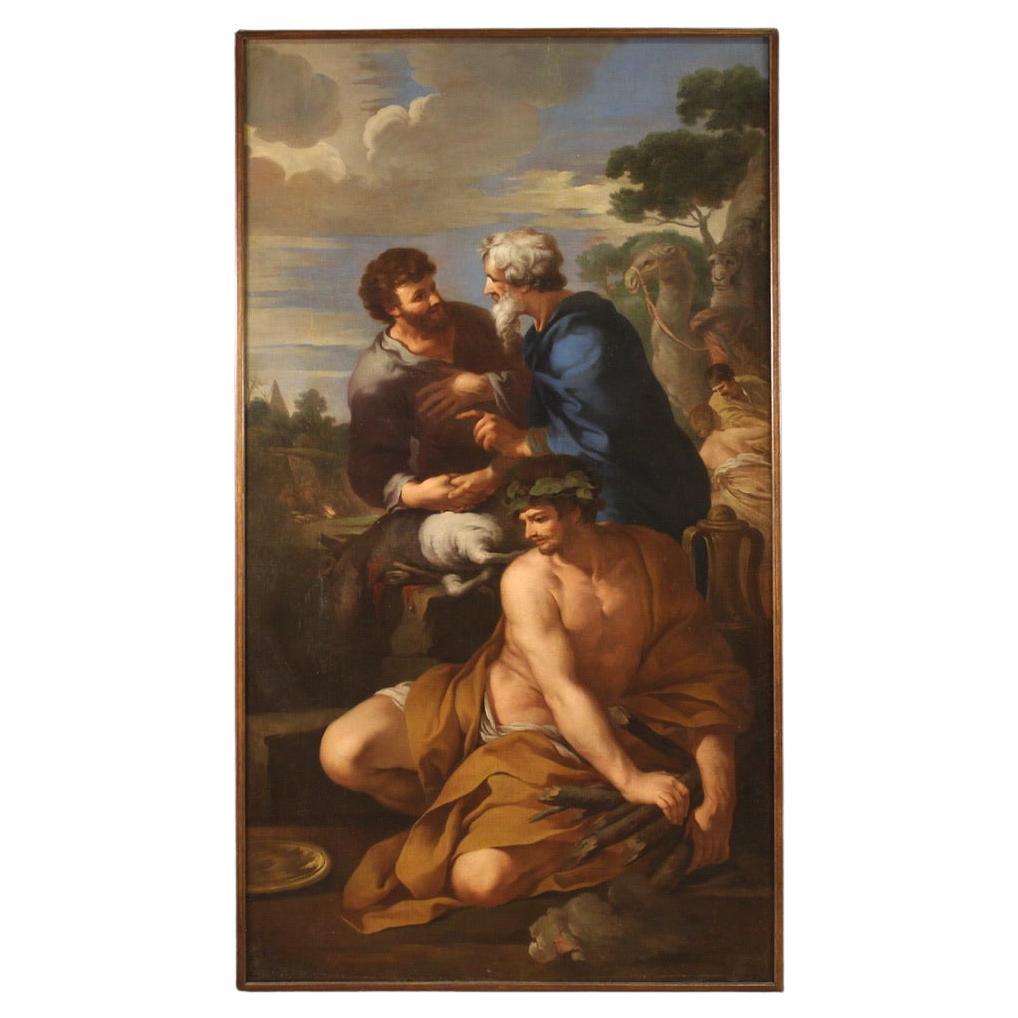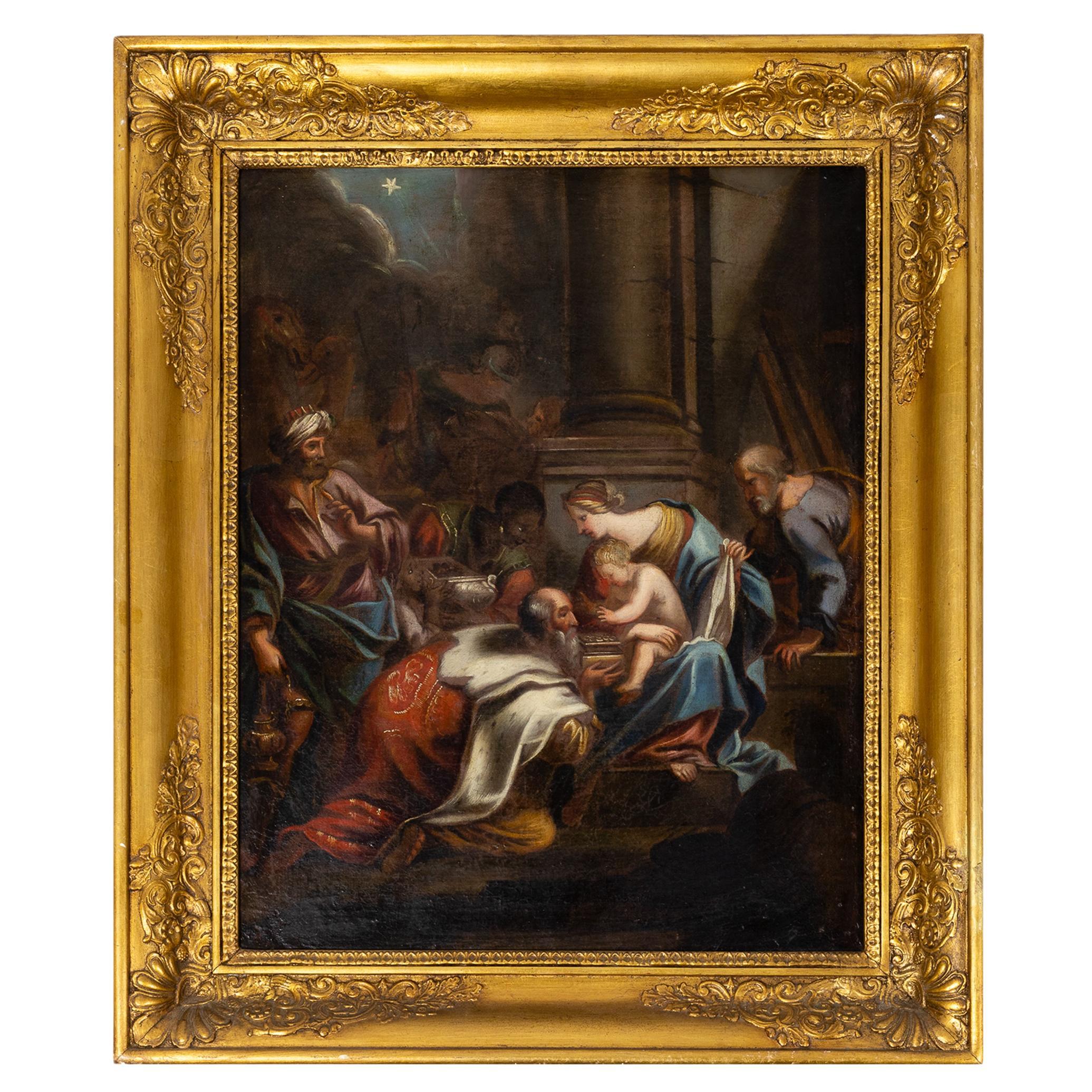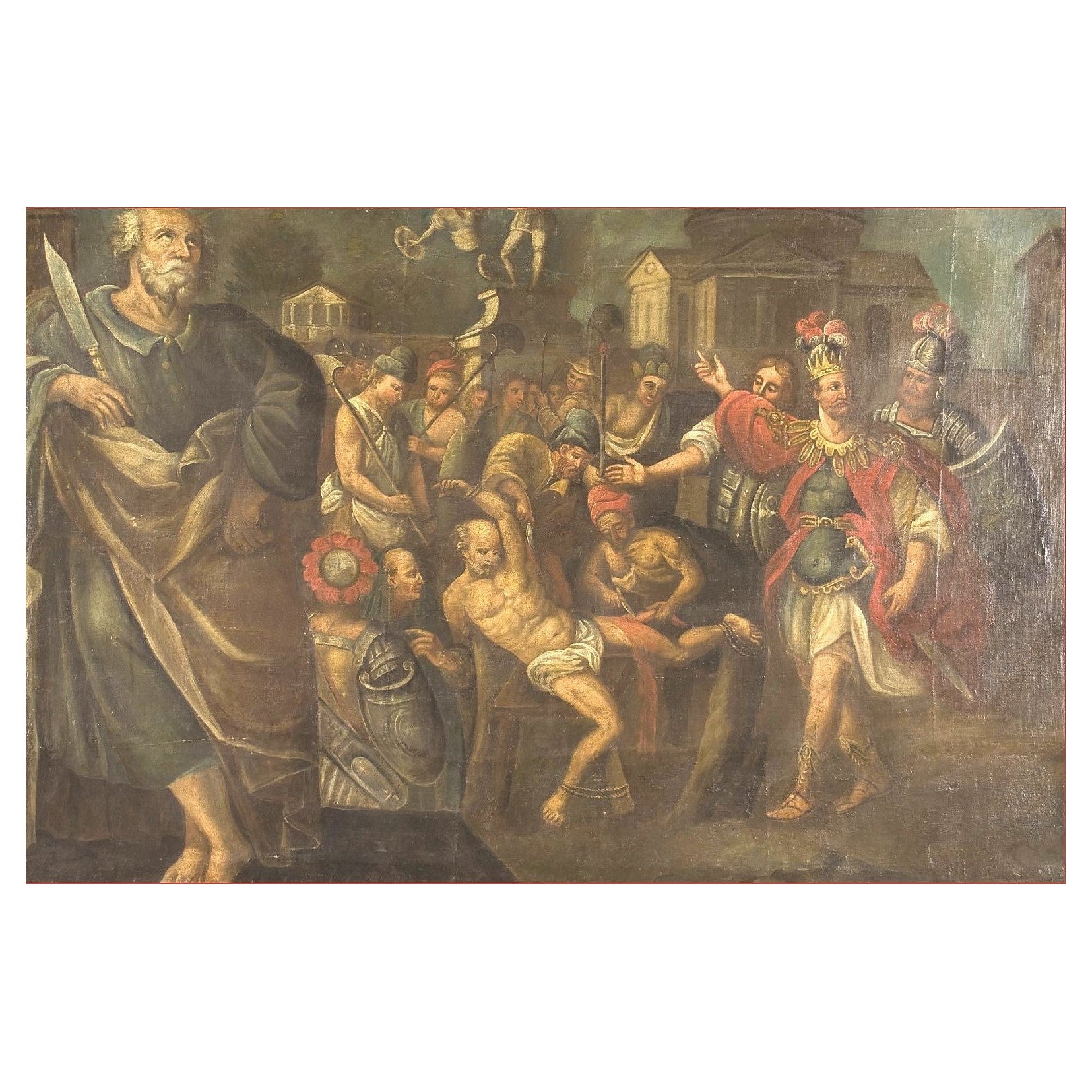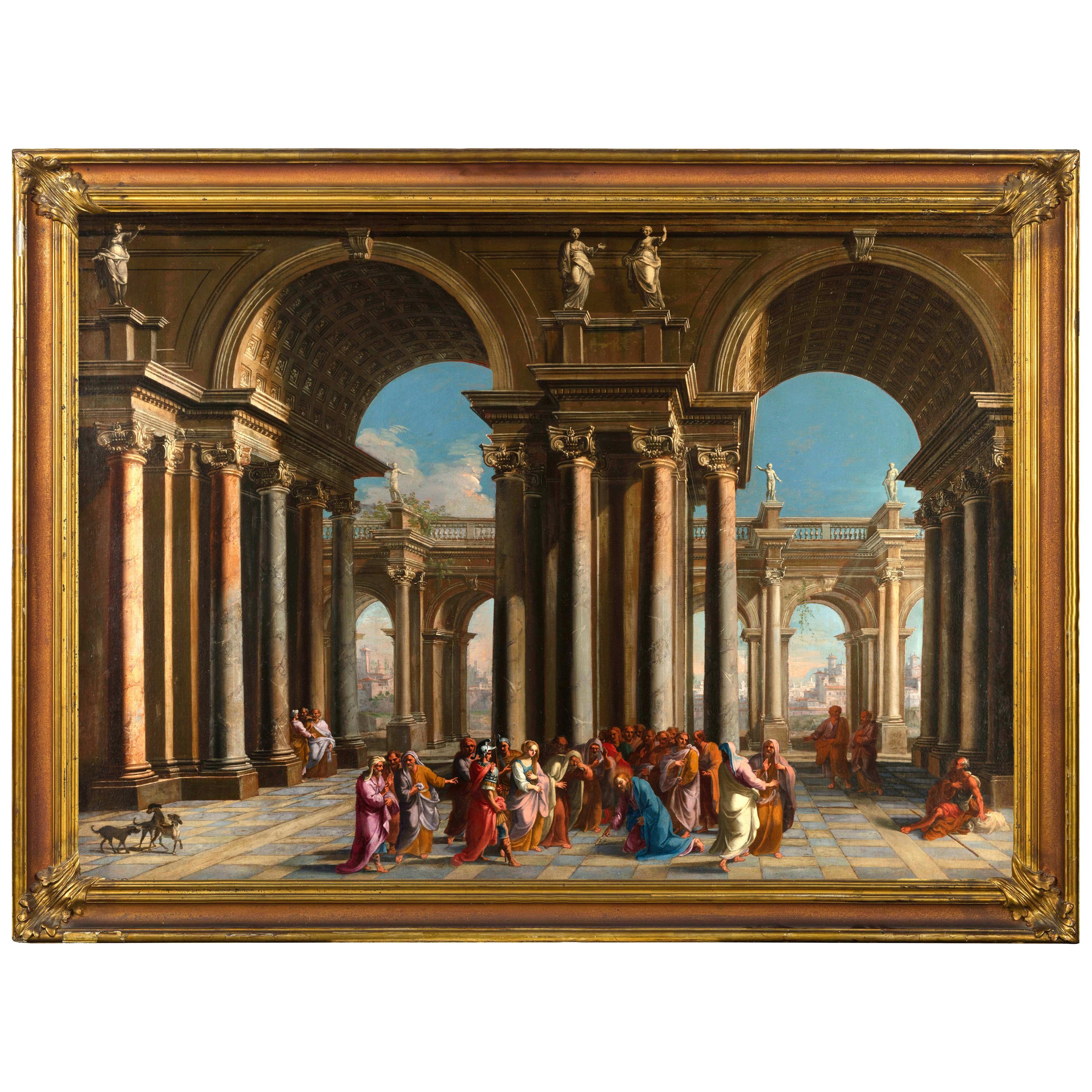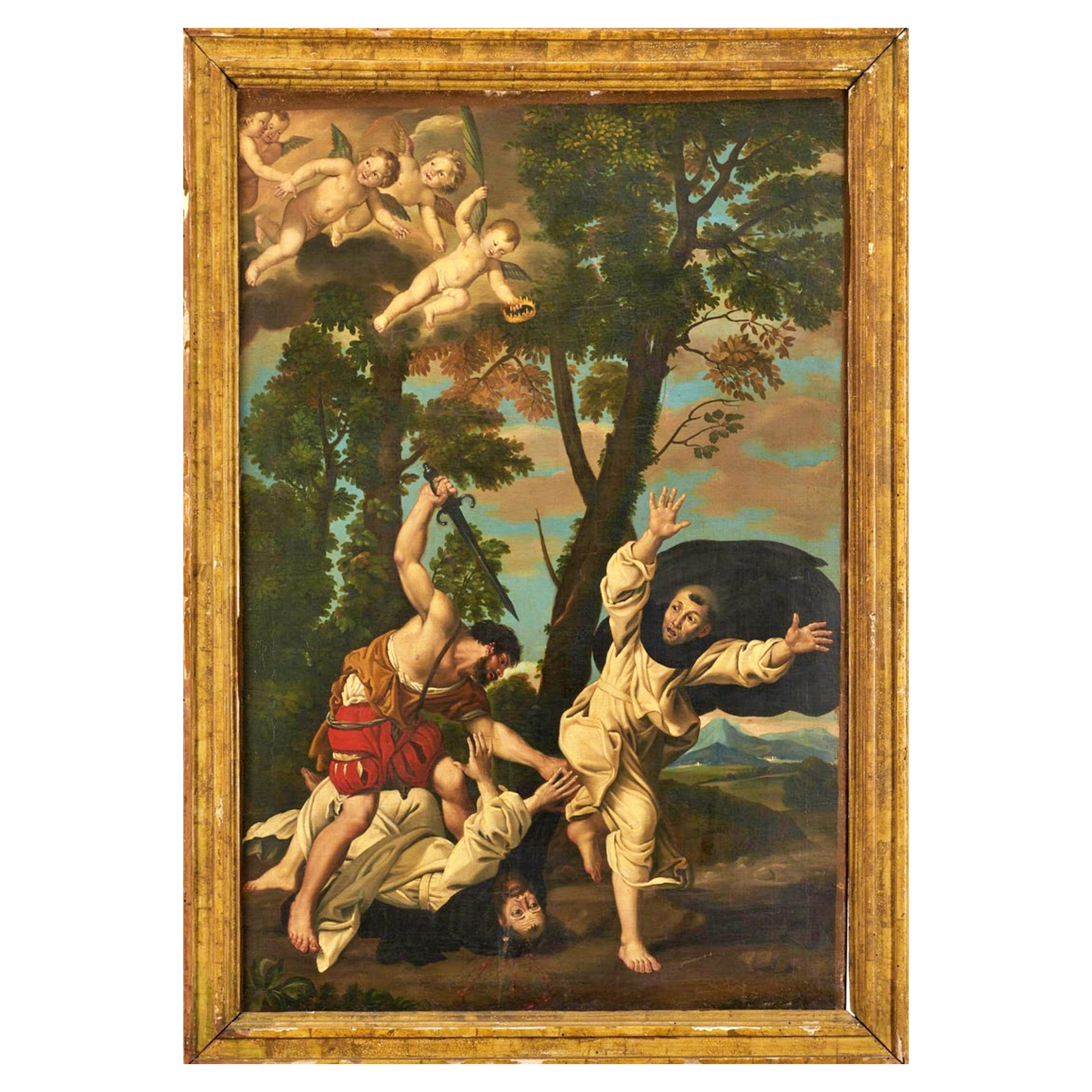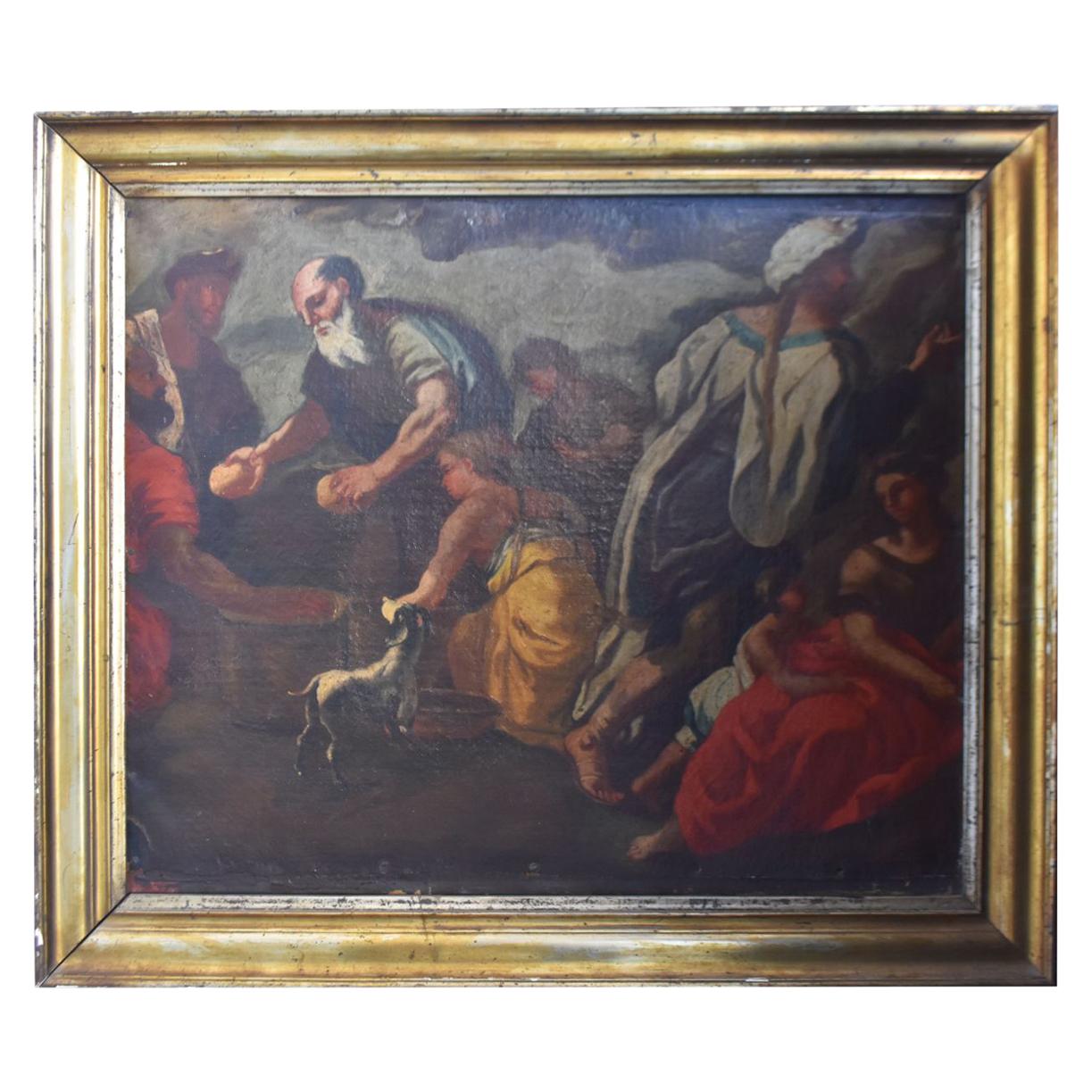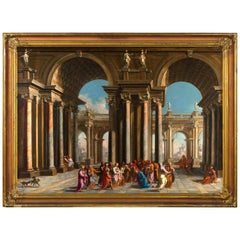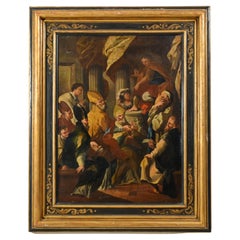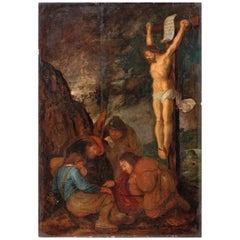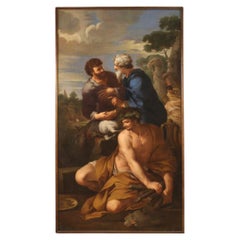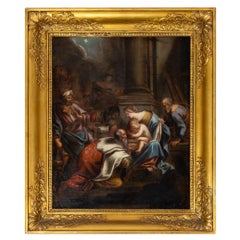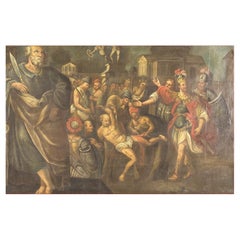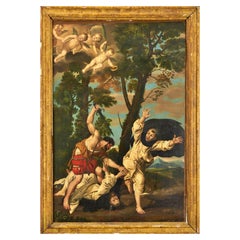Items Similar to 17th Century, The Martyrdom of the Four Crowned Saints by Giuliano Dinarelli
Want more images or videos?
Request additional images or videos from the seller
1 of 5
17th Century, The Martyrdom of the Four Crowned Saints by Giuliano Dinarelli
$14,989.74
£11,150.85
€12,500
CA$20,526.08
A$22,822.20
CHF 11,916.50
MX$277,801.79
NOK 152,049.29
SEK 142,462.92
DKK 95,155.60
Shipping
Retrieving quote...The 1stDibs Promise:
Authenticity Guarantee,
Money-Back Guarantee,
24-Hour Cancellation
About the Item
17th century, The condemnation and martyrdom of the four crowned saints by Giuliano Dinarelli
Mid-17th century, Italy, Bologna
Oil on canvas, frame 84 x 99 cm, only canvas 47 x 61 cm
The painting depicts the condemnation and martyrdom of the four crowned saints: Claudius, Nicostratus, Castorius and Sinforian. In the foreground on the right, behind a curtain and raised by three stone steps, sits the figure of a king with an arm raised in the act of command: it is the Emperor Diocletian as he pronounces the judgment, indicating a classical sculpture of the god Apollo. In front of him are led two men with their arms tied. To the left of the king, two other men, perhaps part of the tribune, take part in the scene.
On the left, in the second floor, two men, kneeling and with their arms tied on their backs, are suffering martyrdom, as indicated by the ferocious gesture of the man who arms raised holds a long sword, just before the massacre. Next to it, a group of people and armed soldiers observe; in heaven a winged putto carries the palm of martyrdom. The subjects are depicted in historical clothes and the scene in the foreground is set inside a palace with marble floor. A jester sits on the steps, playing with a puppy.
Claudio, Nicostrato, Castorio and Sinforiano, represented in the work two in the presence of Diocletian and two during the martyrdom, were skilled stonemasons. According to hagiographic tradition (it is the Gregorian Sacramentary of the 7th century to offer some scanty news) they worked in the marble and porphyry quarries of Sirmium in Pannonia (the current Serbian city Sremska Mitrovica). Their skill led them to believe, by their fellow workers, magicians because, before starting a job, they traced signs of the cross, reciting hymns and prayers, exchanged for magic formulas. The Emperor Diocletian went to Pannonia to find marbles for his buildings, he admired the artistic quality and ordered their columns and decorative elements for his palace in Split, Dalmatia, which he built between 293 and 305 AD. However, one day he commissioned him, in addition to genie, victories and mythological figures, a statue of Aesculapius, the god of health. The four artists, being secretly Christians, performed all that was required of them, but not the statue of the pagan deity, which they refused to realize. Interrogated directly by the emperor, they confessed their religion. They were tried and scourged by the tribune Lampedio, so that they would abjure their faith. Faced with their refusal, they were locked up in lead crates and thrown into the waters of the Danube River. Simplician, a Christian and their fellow worker, recovered his remains trying to bury him. Surprised at the gesture, he was also sentenced to death. In the Middle Ages they became patrons of masons, stonemasons, sculptors and building corporations. The depiction of their condemnation and martyrdom is quite rare in painting. However, it is possible to outline its iconography, in which some characteristics are highlighted: the number of martyrs, the emperor who indicates the idol and the palm of martyrdom. The scene depicted in the work studied, therefore, portrays Diocletian in the act of showing the statue, in this case, of the god Apollo, which the stonemasons refuse to worship. On the right the real martyrdom takes place: two of the saints are scourged and ended with sword blows, while from heaven an angel hands the identifying palm of martyrdom. The statue depicted is to be identified with that of Apollo Citaredo, distinguished by the harp and the mantel (fireplace). There are several Greek Roman sculptures depicting him with different compositional variations, one of which may have been freely interpreted by the painter.
On the back of the canvas, is affixed to the frame a label bearing the inscription with ancient calligraphy “Giuliano Dinarelli Ping(eb)it”. The work is therefore already assigned to the Bolognese painter Giuliano Dinarelli (1614-1629). The stylistic comparison with the artist’s works suggests such a probable attribution, although the corpus of certain works attributed to Dinarelli is still very scarce today.
The information about the painter’s life, which we know to have been a very dear pupil of Guido Reni, is just as sparse. Dinarelli was born in Bologna, brother of Taddea Dinarelli, mother of Giovanni Girolamo Bonesi. The latter was trained in his uncle’s workshop, before finishing his studies in painting with Giovanni Maria Viani.
Lanzi counts Giuliano Dinarelli among the students of Guido Reni and in the inventory of Count Antonio Baglioni of 1680, are reported his works two octaangles with Sante. Among the known works there is also the painting depicting the guardian angel made circa 1660 and preserved in the pillar between the seventh and eighth chapel to the right of the Church of Santa Maria dei Servi, in Bologna. The work is remembered in all the historical sources and guides of the city and is, in the body of known works of the painter, the most famous. Dinarelli is remembered active in Bologna and specializes in religious scenes. The Diocese of Imola preserves some paintings by the painter depicting an Ecce Homo, a Madonna Addolorata, San Pietro and Santa Maria Maddalena. Through the letter of Ferdinando Cospi to Leopoldo de' Medici of 1675, we also learn of a portrait of a woman that the same Cospi offers for sale, claiming to be a work He was made by a master I knew a short time ago dead called Giuliano Dinarelli, one of the good students of Guido Reni who painted very well and imitated his master.
The existence of a painting by Dinarelli, portrait of Antonio Colonna, is evidence of a prestigious commission and, therefore, of an artistic recognition that the painter had with the nobility of the time.
The work, in good condition and recently restored, is enriched by an important coeval frame, carved and golden.
We apologize for any errors in translation from Italian.
- Attributed to:Carlo Piacenza (Artist)
- Dimensions:Height: 33.08 in (84 cm)Width: 38.98 in (99 cm)Depth: 3.94 in (10 cm)
- Style:Baroque (Of the Period)
- Materials and Techniques:
- Place of Origin:
- Period:Mid-17th Century
- Date of Manufacture:Mid-17th Century
- Condition:
- Seller Location:IT
- Reference Number:1stDibs: LU4405218781842
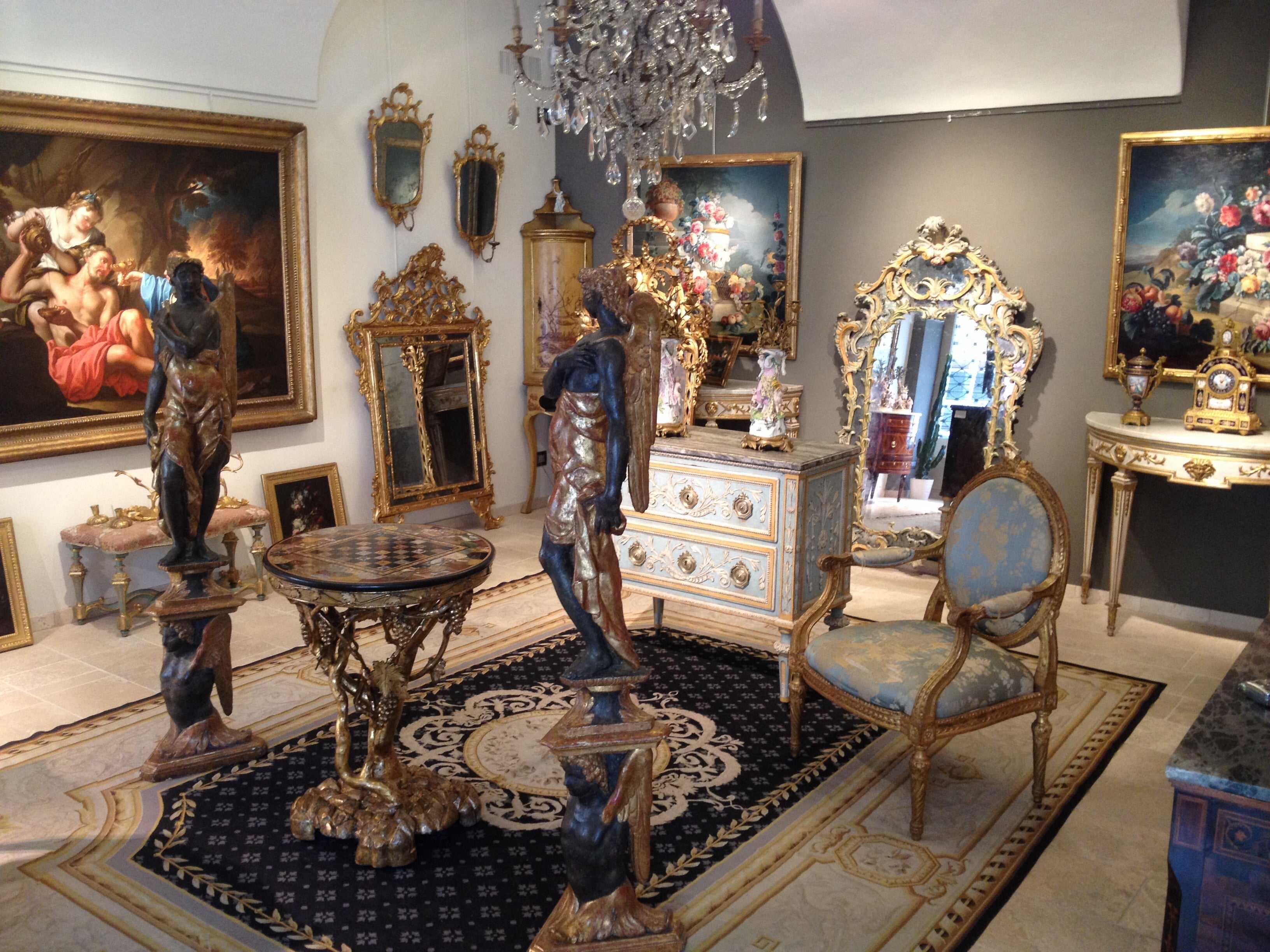
About the Seller
5.0
Platinum Seller
Premium sellers with a 4.7+ rating and 24-hour response times
Established in 1980
1stDibs seller since 2019
56 sales on 1stDibs
Typical response time: 1 hour
- ShippingRetrieving quote...Shipping from: Italy
- Return Policy
Authenticity Guarantee
In the unlikely event there’s an issue with an item’s authenticity, contact us within 1 year for a full refund. DetailsMoney-Back Guarantee
If your item is not as described, is damaged in transit, or does not arrive, contact us within 7 days for a full refund. Details24-Hour Cancellation
You have a 24-hour grace period in which to reconsider your purchase, with no questions asked.Vetted Professional Sellers
Our world-class sellers must adhere to strict standards for service and quality, maintaining the integrity of our listings.Price-Match Guarantee
If you find that a seller listed the same item for a lower price elsewhere, we’ll match it.Trusted Global Delivery
Our best-in-class carrier network provides specialized shipping options worldwide, including custom delivery.More From This Seller
View AllAlberto Carlieri, Capriccio with Christ and the Adulteress, Oil on Canvas
By Alberto Carlieri
Located in IT
Alberto Carlieri (Italy-Roma 1672-1720), "Christ and the adulteress",
Oil on canvas, with frame cm H 115 x L 151 x 6.5, only canvas H 98.5 x L 135 cm...
Category
Antique Late 17th Century Italian Baroque Paintings
Materials
Canvas
18th Century, Italian painting with Saint Nicholas and the miracle of the brick
Located in IT
18th Century, Italian painting with Saint Nicholas and the miracle of the brick
Oil on canvas; Frame cm H 136 x W 109 x D 10. Canvas cm H 100 x W 74
The oil on canvas painting, with...
Category
Antique 18th Century Italian Baroque Paintings
Materials
Canvas
17th Century Flemish Oil on Panel Monogrammist H.C., Soldiers Gambling for Tunic
Located in IT
17th century Flemish oil on panel Monogrammist H. C.
"Soldiers gambling for Christ's tunic"
The fine painting depicts the biblical scene i...
Category
Antique 17th Century Dutch Baroque Paintings
Materials
Wood
Alberto Carlieri, Painting with Architectural Capriccio
By Alberto Carlieri
Located in IT
Alberto Carlieri (Rome 1672-1720)
"Architectural capriccio with the preaching of Saint Paul in the Areopagus of Athens"
Oil on canvas, measures with...
Category
Antique Late 17th Century European Baroque Paintings
Materials
Canvas
18th century, Couple of Italian Paintings Capriccio with Mythological Scenes
Located in IT
Couple of architectural capriccio with mythological scenes, oil on canvas, painter from Bologna active in the 18th century
The two large and valuable pantings depict two architectur...
Category
Antique Early 18th Century Italian Baroque Paintings
Materials
Canvas
17th Century, Italian Painting with Battle attributed to Marzio Masturzo
Located in IT
Marzio Masturzo, attributed (Active in Italy - in Naples and Rome- in the second half of the 17th century)
"Battle between cavalry and vessels with fortified city on the left"
...
Category
Antique Late 17th Century Italian Baroque Paintings
Materials
Canvas
$40,472 Sale Price
25% Off
You May Also Like
17th Century Oil on Canvas Italian Antique Religious Painting, 1650
Located in Vicoforte, Piedmont
Splendid 17th century Italian painting. Oil painting on canvas depicting the alliance of Jacob and Laban. The subject is inspired by a canvas by Pietro da Cortona (1596-1669), preser...
Category
Antique 1650s Italian Paintings
Materials
Canvas
$11,512 Sale Price
20% Off
Free Shipping
Adoration of the Magi Paiting, Italian Baroque Religious Art, 18th Century
Located in Lisbon, PT
This 18th century Italian painting captures one of the most iconic biblical moments: the Adoration of the Magi.
The mysterious travelers kneel in reverence before the Infant Jesus, ...
Category
Antique 18th Century Italian Baroque Paintings
Materials
Canvas
$9,485 Sale Price
20% Off
Antique painting Martyrdom of St. Bartholomew from the 17th century
Located in Cesena, FC
Antique painting Martyrdom of St. Bartholomew, by northern European painter of the 17th century
Oil on canvas 100 x 150 cm
Painting based on a subject by Martin de Vos (1532-1603) a...
Category
Antique 17th Century Belgian Paintings
Materials
Canvas
Italian School according to Domenichino 18th century "Martyrdom of St Peter"
Located in Madrid, ES
Italian school according to Domenichino from the 18th century.
"Martyrdom of St. Peter of Verona"
oil on canvas
(90x60.5cm)
in frame 95cm x 65.5cm
good condition
Category
Antique Early 18th Century Italian Baroque Wallpaper
Materials
Paint
17th Century Italian School Biblical Scene
Located in Marseille, FR
17th century oil on canvas representation of the "Feeding of the 4,000" of Italian school.
Category
Antique 17th Century French Baroque Paintings
Materials
Canvas
Caravaggesque Oil on Copper "Flagellation of Christ" Baroque Sicilian, 17th Cent
By (After) Caravaggio
Located in Milano, IT
Splendid 17th-century Italian painting by unknown artist, but certainly a follower of Caravaggio, relying on style and drawing.
The painting has a very beautiful gilded wooden frame, with a subtle greek with spheres and an overlying rectangular frame with sinuous flowers on each corner, very elegant and beautiful.
The painting depicts one of the most depicted religious scenes ever, the scourging of Christ, and is entirely done in oil on copper.
The scourging of Jesus is an episode narrated in the Gospels (Mk15:15-16; Mt27:26-27; Lk23:16-26; Jn19:1-17[1]).
Scourging is a flogging, particularly bloody, by means of sticks, rods or cat-o-nine-tails, the latter instrument consisting, in the Roman typology, of a short stick to which were secured several strings ending in metal claws, leads and bone splinters that caused tremendous lacerations and fractures to the tortured person. Chains are used in this scene, both to immobilize Jesus Christ and to flog him, as we can see in the upper right hand of the scourger.
According to some personal research, it turned out that the actual scourging of Christ was mostly depicted at the column, while this Christ is on the ground, so presumably Christ here is scourged during the Way of the Cross at one of those stages where he fell.
The painting has a very dark coloring, which is why this painting is believed to faithfully follow Caravaggio's style of dry, authoritarian brushstrokes. The painting shows a figure agonizing on the ground that continues to receive beatings and floggings of all kinds, representing Christ; his face is crucified in a loquacious expression of pain, he turns his eyes to heaven as if to invoke God, but at the same time those same eyes admonish the wickedness and arrogance inherent in humanity.
Christ has one hand resting on the ground in the act of holding himself, while the other takes a completely unnatural stance against the barren ground. His body appears hardened to wanting to parry the blows, his legs are curled up on his knees as he takes kicks from the soldier above him. Christ is depicted pinned down from the neck with a very large and strong black iron bolt held by the other soldier. The soldier on the right in the foreground wears a one-shoulder tunic with an orange tunic and blue pants. On his feet he wears gray shoes, at his waist he has a belt with an iron helmet...
Category
Antique 17th Century Italian Baroque Paintings
Materials
Copper
$17,268 Sale Price
20% Off
More Ways To Browse
Men Of The Day
Angel Wall Sculptures
Sword Case
Antique Marble Pillar
Ancient Greek Cross
Christian Wall Sculpture
Antique Idols
17th Century Swords
Angel Kneeling
Italian Jester
Church Kneeler
Giovanni Bologna
Greek God Wall Sculpture
Italian Angel Statues
Antique Lead Soldier
Ancient Roman Sword
Madonna Statues
Harp Case
